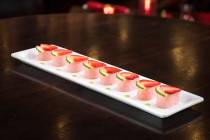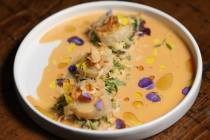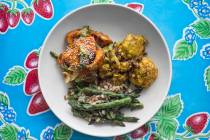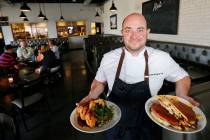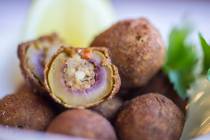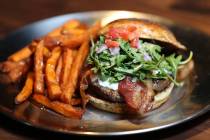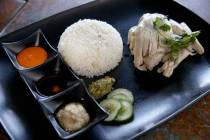Salvadoreño
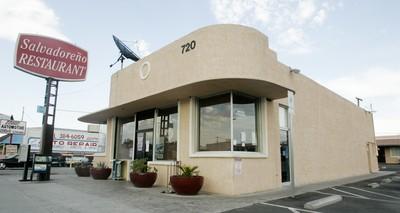
There were two things we noticed upon entering Salvadoreño, and we noticed them simultaneously:
One was that they’d cleaned up the place since we’d last been in for lunch a few years ago. While we remembered a restaurant that was well-used to the point of down-about-the-heels (and for some reason I recall blue, as in that there must have been a lot of blue paint), things have been spiffed up considerably. Now there’s a pleasant color scheme of neutral shades of brown, with fresh paint, new tile on the floor and walls and attractive tables and chairs.
Which makes the other thing we noticed all the more puzzling. That would be the pervasive odor of cigarette smoke — specifically, stale cigarette smoke, such as we used to suffer in budget motel rooms. The friend I’d taken with me on this mission is a smoker and noticed it as well. It was so pervasive that it wasn’t until we were well into our entrees that the food aromas helped to mask the smell. Since no one was smoking — and since the odor was specifically that of stale cigarette smoke — its source remains a mystery.
Salvadoreño was a mixed bag in other ways, including the food and service; the latter started out great but became rather distracted as the restaurant began to fill up.
If you’re not familiar with Salvadoran food, look at a map pinpointing El Salvador’s place in the world and you’ll understand that its cuisine has much in common with those of cultures close to its location in Central America, such as Mexico to the northwest and the tropics to the east. Beans and corn are major mainstays; so are plantains.
The most well-known of Salvadoran dishes is the pupusa, and Salvadoreño offers them in a number of variations. We chose the cheese ($1.65) and were served a soft, thick tortilla (in the Salvadoran style) stuffed with a slightly oozy, melted mild cheese. What made this pupusa truly enjoyable was that the tortilla had been grilled until it was lightly charred, lending a smoky, nutty flavor that enhanced both flavor and texture.
And what could be more typical than an entree billed Salvadoran Typical Plate ($8.99)? This one involved grilled steak, sauteed ripe plantains, chunks of cheese, casamiento and tortillas.
Casamiento is the Salvadoran term for the black beans and white rice that’s a staple in this part of the world. The term translates to "wedding," which we find somewhat more charming than the Cuban "moros y cristianos," which translates to "moors and Christians." At any rate, the beans were quite nice, well-seasoned and mellow, and perfect in combination with the rice.
The plantains were soft and slightly sweet, the chunks of cheese mild of flavor and firm of texture. The steak was, as we would expect in a Central American restaurant (and especially at these prices) a thin cut of beef, which means it would cook quickly and be somewhat tricky to cook to anything less than medium. But our waitress had taken pains to ask how we wanted it prepared, and medium-rare it was not — except on, as might be expected, the thicker end. Still, it was reasonably tender and had a nice char-broiled flavor.
But overcooking also was a bit of a problem with our other entree, the char-broiled chicken ($7.99). Again, it was nicely charred, but not so quickly that the skin didn’t caramelize. Unfortunately, that hot, fairly slow cooking gave us a half-chicken that was way too dry. We’d been served a bowl of the typical Salvadoran marinated cabbage, curtido, with our appetizers, and the chicken platter included a cup of what seemed to be curtido juice, which did much to moisten the parched bird. But not enough.
Rice, potatoes and corn on the cob came with this one for a bit of a carb frenzy. The potatoes were large wedge fries and very good; the rice was fluffy and flecked with bits of vegetable. But I’ve long wondered why restaurants even attempt to serve corn on the cob because it’s almost never good, and that was the case here, the corn somehow waterlogged and dried-out at the same time.
We’d ordered an appetizer of plantains ($3) before realizing that there’d be some on the Salvadoran Typical Plate as well, but didn’t mind the overload, and we did like the crema served with the appetizer version. The creme frâiche-like Salvadoran version of sour cream did a lot to rein in the plantains’ sweetness.
Throughout our dinner, the restaurant’s sound system carried a panoply of the best that the disco era had to offer. As we were paying the bill it was switched to something more traditional and a soccer game was tuned in on a plasma screen, but that seemed almost a shame. The strange mix presented by casamiento served to the strains of "Saturday Night Fever" seemed emblematic of Salvadoreño itself.
Las Vegas Review-Journal reviews are done anonymously, at Review-Journal expense. Contact Heidi Knapp Rinella at 383-0474 or e-mail her at hrinella@ reviewjournal.com.
HEIDI KNAPP RINELLAMORE COLUMNSwhat: Salvadoreño where: 720 N. Main St. phone: 385-3600 overall:C+ food: C+ atmosphere: B- service: C+ pluses: Good plantains, casamiento, curtido. minuses: Overcooked meat and lingering smoke.









